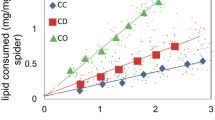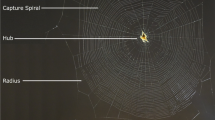Abstract
It has been suggested that physical interactions between biological and environmental surfaces may constrain ecological niche spaces. However, the mechanistic understanding of niche formation is frequently limited by the lack of information on the function and variation of these interactions. Here, we hypothesised that two closely related species of orb-web spiders have evolved different adhesion performance of web attachment (i.e. piriform silk) facilitating the occupation of contrasting microhabitats: plants versus rocks. Contrary to our prediction, we found that piriform silk adhesion was equally affected by surface chemistry in both species, with maximal adhesion on surfaces with high surface polarity and an average adhesion loss of 70–75% on low polar surfaces. Spiders did not respond to adhesion losses by increasing the anchor size, despite the repeated failure to attach their web to low polar surfaces. In a natural setting, poor adhesion on low polar surfaces may be mitigated by behavioural means, like the preference to place anchors on corrugated surface features such as leaf edges, or the spinning of multiple anchorages and formation of a bundled anchor line. Thus, microhabitat choice for web-building spiders may be governed by structural properties rather than surface chemistry. These results suggest that the repeatedly demonstrated effects of surface chemistry on bio-adhesion may be ecologically less important than assumed and that the role of behaviour in the evolution of bio-adhesion performance has been underestimated.



Similar content being viewed by others
References
Afferrante L, Carbone G (2016) The ultratough peeling of elastic tapes from viscoelastic substrates. J Mech Phys Solids 96:223–234
Amarpuri G, Zhang C, Diaz C, Opell BD, Blackledge TA, Dhinojwala A (2015) Spiders tune glue viscosity to maximize adhesion. ACS Nano 9:11472–11478
Bates D, Maechler M, Bolker B, Walker S (2015) Fitting linear mixed-effects models using lme4. J Stat Softw 67:1–48
Berglin M, Gatenholm P (1999) The nature of bioadhesive bonding between barnacles and fouling-release silicone coatings. J Adhes Sci Technol 13:713–727
Betz O, Kölsch G (2004) The role of adhesion in prey capture and predator defence in arthropods. Arthropod Struct Dev 33:3–30
Bhushan B, Wyant JC, Koliopoulos CL (1985) Measurement of surface topography of magnetic tapes by Mirau interferometry. Appl Opt 24:1489–1497
Brau F, Lanterbecq D, Zghikh L-N, Bels V, Damman P (2016) Dynamics of prey prehension by chameleons through viscous adhesion. Nat Phys 12:931–935
Callow ME, Fletcher RL (1994) The influence of low surface energy materials on bioadhesion—a review. Int Biodeterior Biodegrad 34:333–348
Crawford N, Endlein T, Pham JT, Riehle M, Barnes WJP (2016) When the going gets rough–studying the effect of surface roughness on the adhesive abilities of tree frogs. Beilstein J Nanotechnol 7:2116–2131
Crisp D, Walker G, Young G, Yule A (1985) Adhesion and substrate choice in mussels and barnacles. J Colloid Interface Sci 104:40–50
De Groot PJ (1995) Derivation of algorithms for phase-shifting interferometry using the concept of a data-sampling window. Appl Opt 34:4723–4730
Eisner T, Aneshansley DJ (2000) Defense by foot adhesion in a beetle (Hemisphaerota cyanea). Proc Natl Acad Sci 97:6568–6573
England MW, Sato T, Yagihashi M, Hozumi A, Gorb SN, Gorb EV (2016) Surface roughness rather than surface chemistry essentially affects insect adhesion. Beilstein J Nanotechnol 7:1471–1479
Federle W, Rohrseitz K, Holldobler B (2000) Attachment forces of ants measured with a centrifuge: better ‘wax-runners’ have a poorer attachment to a smooth surface. J Exp Biol 203:505–512
Gorb S (2001) Attachment devices of insect cuticle. Springer Science & Business Media, Dordrecht
Grawe I, Wolff JO, Gorb SN (2014) Composition and substrate-dependent strength of the silken attachment discs in spiders. J R Soc Interface 11:1742–5662
Grohmann C, Blankenstein A, Koops S, Gorb SN (2014) Attachment of Galerucella nymphaeae (Coleoptera, Chrysomelidae) to surfaces with different surface energy. J Exp Biol 217:4213–4220
Hansell MH (2005) Animal architecture. Oxford University Press, New York
Heepe L, Petersen DS, Tölle L, Wolff JO, Gorb SN (2017) Sexual dimorphism in the attachment ability of the ladybird beetle Coccinella septempunctata on soft substrates. Appl Phys A Mater Sci Process 123:34
Heepe L, Wolff JO, Gorb SN (2016) Influence of ambient humidity on the attachment ability of ladybird beetles (Coccinella septempunctata). Beilstein J Nanotechnol 7:1322–1329
Herberstein ME (2000) Foraging behaviour in orb-web spiders (Araneidae): do web decorations increase prey capture success in Argiope keyserlingi Karsch, 1878? Aust J Zool 48:217–223
Hesselberg T (2013) Web-building flexibility differs in two spatially constrained orb spiders. J Insect Behav 26:283–303
Huber G, Mantz H, Spolenak R, Mecke K, Jacobs K, Gorb SN, Arzt E (2005) Evidence for capillarity contributions to gecko adhesion from single spatula nanomechanical measurements. Proc Natl Acad Sci 102:16293–16296
Kendall K (1975) Thin-film peeling—elastic term. J Phys D Appl Phys 8:1449–1452
Lenth R, Singmann H, Love J, Buerkner P, Herve M (2018) Emmeans: estimated marginal means, aka least-squares means, R package version 1.1. https://cran.r-project.org/package=emmeans
Niewiarowski PH, Lopez S, Ge L, Hagan E, Dhinojwala A (2008) Sticky gecko feet: the role of temperature and humidity. PLoS One 3:e2192
Opell B (1998) Economics of spider orb-webs: the benefits of producing adhesive capture thread and of recycling silk. Funct Ecol 12:613–624
Piorkowski D, Blackledge T, Liao CP, Doran N, Wu CL, Blamires S, Tso IM (2018) Humidity-dependent mechanical and adhesive properties of Arachnocampa tasmaniensis capture threads. J Zool 305:256–266
Pugno NM (2011) The theory of multiple peeling. Int J Fract 171:185–193
Pugno NM, Cranford S, Buehler MJ (2013) Synergetic material and structural optimization yields robust spider web anchorages. Small 9:2747–2756
Puthoff JB, Prowse MS, Wilkinson M, Autumn K (2010) Changes in materials properties explain the effects of humidity on gecko adhesion. J Exp Biol 213:3699–3704
R Core Team (2016) R: a language and environment for statistical computing. R Foundation for Statistical Computing. https://www.R-project.org/
Rao D, Cheng K, Herberstein ME (2007) A natural history of web decorations in the St. Andrew’s Cross spider (Argiope keyserlingi). Aust J Zool 55:9–14
Sahni V, Harris J, Blackledge TA, Dhinojwala A (2012) Cobweb-weaving spiders produce different attachment discs for locomotion and prey capture. Nat Commun 3:1–7
Schnee L, Sampalla B, Müller JK, Betz O (2019) A comparison of tarsal morphology and traction force in the two burying beetles Nicrophorus nepalensis and Nicrophorus vespilloides (Coleoptera, Silphidae). Beilstein J Nanotechnol 10:47–61
Schneider CA, Rasband WS, Eliceiri KW (2012) NIH image to ImageJ: 25 years of image analysis. Nat Methods 9:671–675
Searle SR, Speed FM, Milliken GA (1980) Population marginal means in the linear model: an alternative to least squares means. Am Stat 34:216–221
Shin D, Choi WT, Lin H, Qu Z, Breedveld V, Meredith JC (2019) Humidity-tolerant rate-dependent capillary viscous adhesion of bee-collected pollen fluids. Nat Commun 10:1379
Stalder AF, Kulik G, Sage D, Barbieri L, Hoffmann P (2006) A snake-based approach to accurate determination of both contact points and contact angles. Colloids Surf A Physicochem Eng Asp 286:92–103
Voigt D, de Souza E, Kovalev A, Gorb S (2019) Inter-and intraspecific differences in leaf beetle attachment on rigid and compliant substrates. J Zool 307:1–8
von Byern J et al (2019) Biomechanical properties of fishing lines of the glowworm Arachnocampa luminosa (Diptera; Keroplatidae). Sci Rep 9:1–14
von Byern J, Grunwald I (2010) Biological adhesive systems: from nature to technical and medical application. Springer, Vienna
Walter A, Elgar MA (2016) Signal polymorphism under a constant environment: the odd cross in a web decorating spider. Sci Nat 103:93
Whitney HM, Federle W (2013) Biomechanics of plant-insect interactions. Curr Opin Plant Biol 16:105–111
Wirth M, Wolff JO, Appel E, Gorb SN (2019) Ultrastructure of spider thread anchorages. J Morphol 280:534–543
Wolff JO (2017) Structural effects of glue application in spiders—what can we learn from silk anchors? In: Xue L, Heepe L, Gorb SN (eds) Bio-inspired structured adhesives. NanoScience and Technology. Springer Science+Business Media, Dordrecht, pp 63–80
Wolff JO, García-Hernández S, Gorb SN (2016) Adhesive secretions in harvestmen (Arachnida: Opiliones). In: Smith AM, Callows JA (eds) Biological adhesives. Springer, Cham, pp 281–301
Wolff JO, Gorb SN (2011) The influence of humidity on the attachment ability of the spider Philodromus dispar (Araneae, Philodromidae). Proc R Soc B 279:139–143
Wolff JO, Gorb SN (2012) Surface roughness effects on attachment ability of the spider Philodromus dispar (Araneae, Philodromidae). J Exp Biol 215:179–184
Wolff JO, Gorb SN (2016) Attachment structures and adhesive secretions in arachnids. Biologically-inspired systems. Springer, Cham
Wolff JO, Grawe I, Wirth M, Karstedt A, Gorb SN (2015a) Spider's super-glue: thread anchors are composite adhesives with synergistic hierarchical organization. Soft Matter 11:2394–2403
Wolff JO, Herberstein ME (2017) 3D-printing spiders: back-and-forth glue application yields silk anchorages with high pull-off resistance under varying loading situations. J R Soc Interface 14:20160783
Wolff JO, Huber SJ, Gorb SN (2015b) How to stay on mummy's back: morphological and functional changes of the pretarsus in arachnid postembryonic stages. Arthropod Struct Dev 44:301–312
Wolff JO, Jones B, Herberstein ME (2018) Plastic material investment in load-bearing silk attachments in spiders. Zoology 131:45–47
Wolff JO, Lovtsova J, Gorb E, Dai Z, Ji A, Zhao Z, Jiang N, Gorb SN (2017a) Strength of silk attachment to Ilex chinensis leaves in the tea bagworm Eumeta minuscula (Lepidoptera, Psychidae). J R Soc Interface 14:20170007
Wolff JO, Paterno GB, Liprandi D, Ramírez MJ, Bosia F, Meijden A, Michalik P, Smith HM, Jones BR, Ravelo AM, Pugno N, Herberstein ME (2019) Evolution of aerial spider webs coincided with repeated structural optimization of silk anchorages. Evolution 73:2122–2134
Wolff JO, Řezáč M, Krejčí T, Gorb SN (2017b) Hunting with sticky tape: functional shift in silk glands of araneophagous ground spiders (Gnaphosidae). J Exp Biol 220:2250–2259
Wolff JO, Schönhofer AL, Schaber CF, Gorb SN (2014) Gluing the ‘unwettable’: soil-dwelling harvestmen use viscoelastic fluids for capturing springtails. J Exp Biol 217:3535–3544
Wolff JO, van der Meijden A, Herberstein ME (2017c) Distinct spinning patterns gain differentiated loading tolerance of silk thread anchorages in spiders with different ecology. Proc R Soc B 284:20171124
Zschokke S, Herberstein ME (2005) Laboratory methods for maintaining and studying web-building spiders. J Arachnol 33:205–213
Acknowledgements
Thanks to Alan Henderson (Minibeasts Wildlife, Kuranda, QLD) for providing A. mascordi individuals and to André Walter (Aarhus University) for providing habitat photos and observational details of A. mascordi.
Availability of data and material
Raw data are deposited in the electronic supplemental material.
Code availability
NA
Funding
This study was supported by a Macquarie Research Fellowship of Macquarie University and a Discovery Early Career Researcher Award of the Australian Research Council (DE190101338) to JOW.
Author information
Authors and Affiliations
Contributions
JOW and MEH conceived and designed the study. JOW performed the experiments and analysed the data. DL performed the profilometric measurements of substrate surfaces. JOW wrote the paper and all other authors equally contributed in revision.
Corresponding author
Ethics declarations
Competing interests
The authors declare that they have no competing interests.
Ethics approval
All applicable international and national guidelines for the care and use of animals were followed.
Consent to participate
NA
Consent for publication
NA
Additional information
Communicated by: Matjaž Gregorič
Publisher’s note
Springer Nature remains neutral with regard to jurisdictional claims in published maps and institutional affiliations.
Rights and permissions
About this article
Cite this article
Wolff, J.O., Little, D. & Herberstein, M.E. Limits of piriform silk adhesion—similar effects of substrate surface polarity on silk anchor performance in two spider species with disparate microhabitat use. Sci Nat 107, 31 (2020). https://doi.org/10.1007/s00114-020-01687-w
Received:
Revised:
Accepted:
Published:
DOI: https://doi.org/10.1007/s00114-020-01687-w




